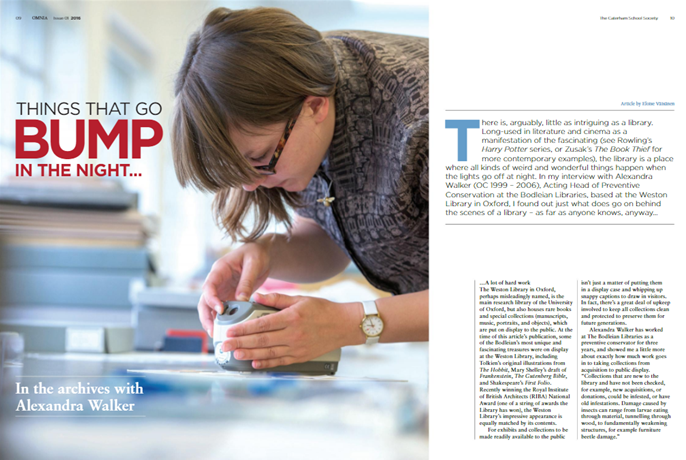B2C Writing (Education) – A Sample by Eloise Väisänen
Aim: Boost engagement of alumni with Caterham School
Medium: Digital and print magazine

There is, arguably, little as intriguing as a library. Long-used in literature and cinema as a manifestation of the fascinating (see Rowling’s Harry Potter series, or Zusak’s The Book Thief for more contemporary examples), the library is a place where all kinds of weird and wonderful things happen when the lights go off at night. In my interview with Alexandra Walker (OC 1999 – 2006), Acting Head of Preventative Conservation at the Bodleian Libraries, based at the Weston Library in Oxford, I found out just what does go on behind the scenes of a library – as far as anyone knows, anyway…
—A lot of hard work
The Weston Library in Oxford, perhaps misleadingly names, is the main research library of the University of Oxford, but also houses rare books and special collections (manuscripts, music, portraits and objects), which are put on display to the public. At the time of this article’s publication, some of the Bodleian’s most unique and fascinating treasures were on display at the Weston Library, including Tolkein’s original illustrations from The Hobbit, Mary Shelley’s draft of Frankenstein, The Gutenberg Bible, and Shakespeare’s First Folio.
Recently winning the Royal Institute of British Architects (RIBA) National Award (one of a string of awards the Library has won), the Weston Library’s impressive appearance is equally matched by its contents.
For exhibits and collections to be made readily available to the public isn’t just a matter of putting them in a display case and whipping up snappy captions to draw in visitors. In fact, there’s a great deal of upkeep involved to keep all collections clean and protected to preserve them for future generations.
Alexandra Walker has worked at The Bodleian Libraries as a preventative conservator for three years and showed me a little more about exactly how much work goes in to taking collections from acquisition to public display.
“Collections that are new to the Library and have not been checked, for example, new acquisitions, or donations, could be infested, or have old infestations. Damage caused by insects can range from larvae eating through material, tunnelling through wood, to fundamentally weakening structures, for example, furniture beetle damage.”
Read more of this article here
